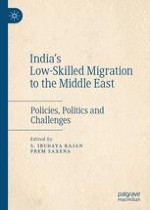2019 | OriginalPaper | Buchkapitel
3. Egyptian Labour Migration in the Arab Middle East
verfasst von : Ibrahim Awad, Lina Lotayef
Erschienen in: India’s Low-Skilled Migration to the Middle East
Verlag: Springer Nature Singapore
Aktivieren Sie unsere intelligente Suche, um passende Fachinhalte oder Patente zu finden.
Wählen Sie Textabschnitte aus um mit Künstlicher Intelligenz passenden Patente zu finden. powered by
Markieren Sie Textabschnitte, um KI-gestützt weitere passende Inhalte zu finden. powered by
